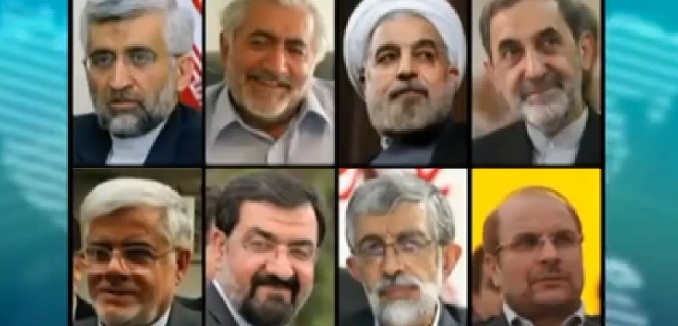Today, an estimated fifty million Iranians are going to elect the seventh president of the Islamic Republic of Iran. There are six candidates left in the race. One of them is Hassan Rohani, who, nearly ten years ago, was the Secretary General of the Supreme National Security Council (SGSNS) and its chief nuclear negotiator with the IAEA and the big powers.
He served then under the relatively moderate President Mohammad Khatami, and is now the big hope of Iran’s reformist movement. The other five candidates can be described as representing different aspects of the arch conservative camp led by the Supreme leader Ali Khaminei.
The turnout will most probably be lower than the 85% in the last elections in 2009, which ensured the second term of Khaminei’s then-favorite, the contentious Mahmud Ahmadinejad.
To win the race one of the candidates has to receive at least 50% of the eligible vote. If not, the two winners of the first round will challenge each other in a second round to be held a week later.
Two surprises can occur: one tactical and one strategic.
The tactically interesting scenario would invovle Mohammad Bagher Ghalibaf, the Mayor of Tehran, winning the election. Ghalibaf, a pilot and an engineer, served in the past as the Police Commissioner of the capital. He sent troops to suppress student demonstrations. As a former member of the Revolutionary Guards, he is perceived as representing their economic and political interests. This time, however, Khaminei’s favorite is Saeed Jalili, the current Secretary General of the Supreme National Security Council, who is considered the most extreme and anti-western among the candidates.
The strategic surprise will be if Rohani wins against all odds. But most Iran observers discount such a possibility. But even Rohani, with his softer approach to foreign policy, believes that Iran has to proceed with its nuclear program, albeit with a less contentious “in your face” approach.
If Rohani and Ghalibaf qualify for the second round it will be a humiliation for the aging supreme Leader.
Regardless, as far as Israel and the West are concerned, whoever is elected the new president will not bring about any change in the foreign policy and the nuclear program, which will continue to be controlled by the Supreme leader.
In other words Iran will continue to advance its nuclear program. There is a double dilemma. One is for Iran. The other is for Israel, the United States, and the West generally.
The Iranian dilemma is whether to assemble the bomb or not. Iran is very close to mastering the technology and know-how to produce its first nuclear weapon. It can probably do so in matter of three to five months. Iran already knows how to enrich uranium and it has gained significant knowledge and experience in full weaponization.
According to IAEA reports, Iran has already a stockpile of 190 kilograms of 20% enriched uranium. To produce one bomb, Iran would need 240 kilograms of 20% enriched uranium further enriched to 93%, which would be done by spinning it in centrifuges. The enrichment process would produce 24 kilograms of highly enriched uranium, which is sufficient fissile material for one bomb.
Iran could easily have had that already, but in the recent months it has slowed down enrichment and diverted some of its 20% enriched uranium into a form known as “plates,” which can be used as nuclear fuel to operate its small research reactor in Tehran. Most experts believe that Iran has been doing it in order to avoid reaching the 240 kilograms threshold and triggering an immediate crisis.
Under this theory, Iran fears that by crossing this threshold now it iwll trigger an Israeli or American military strike against its nuclear sites. Israeli Prime Minister Benjamin Netanyahu, who, in his speech to the UN General assembly in September 2012 defined the 240 kilograms threshold as a “red-line.”
But there might be other reasons for Iran’s reluctance to build a big, clumsy, first nuclear bomb. At the moment, Iran lacks effective delivery vehicles. Its air force is old and outdated. Iran may prefer to wait more time until it will be able to build a bomb which can be fitted to a warhead atop a missile. Israel and American intelligence analysts believe such a capability will be achieved within a year, or 18 months the most.
Iran is also waiting to open its 40 megawatt nuclear reactor in Arak, where it would be able to produce plutonium. Plutonium bombs are stronger, and lighter than uranium bombs. It is estimated that the Arak reactor will be operational in mid 2014.
Other analysts have suggested that Iran’s delays are signals that Tehran will settle for a so-called virtual arsenal, under which it would indefinitely maintain the material and know-how to create a bomb in a matter of weeks once a political decision is made to do so. The U.S. and other Western powers might, under that situation, refrain from taking military action against Iran’s nuclear infrastructure.
Past declarations by Netanyahu and his senior officials suggest that they view an Iranian virtual arsenal the same as an actual arsenal. It is unlikely, however, that Israel would make the decision to strike without United States or Western support, which may not be forthcoming unless Iran settles for the “virtual arsenal” option.
[Photo: PressTVGlobalNews / YouTube]




